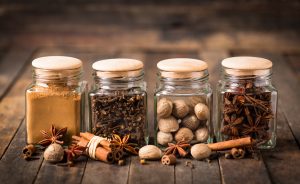Where do those sugar and spices we use in holiday baking come from?
By Nicole Flowers-Kimmerle University of Illinois Extension Services — December 13, 2022
Making homemade Christmas cookies are a tradition that stands the test of time and generations.
Sugar and spice make everything nice, especially Christmas cookies. But, do you know where your sugar and spice come from?
Plants make the sugar glucose during photosynthesis. Certain plants can take excess glucose, create sucrose then store it in either the stalk or root. This is the sugar we use every day to sweeten treats from coffee to cookies. Sugar adds sweetness, gives a tender texture, and allows browning to occur in baked goods.
The common sugar we use comes from two different plants: sugar beets or sugarcane. The United States is one of the largest sugar producers in the world due to its well-developed sugar cane and sugar beet industries.
Sugarcane
Worldwide, 70 percent of our sugar comes from sugarcane. Sugarcane is a tall grass that grows in tropical areas. In a tropical setting like Hawaii and Jamaica, it grows in fields and looks similar to corn. Florida is the largest producer of sugarcane in the United States.
To get sugar from sugarcane, the cane is pressed to extract the juice, then boiled, and spun to produce raw sugar and syrup (molasses). The raw sugar is then sent to a refinery where it is washed and filtered to remove remaining non-sugar ingredients and color. It is then crystallized, dried, and packaged into refined (or granulated) sugar.
Sugar beets
Most of the sugar we eat here probably came from sugar beets. Sugar beets are a root crop resembling a large parsnip grown mostly in the temperate zones of the north. Beets are harvested after the temperature drops to preserve the high sugar levels until processing.
Beet sugar processing is similar to sugarcane, but it is done in one continuous process without the raw sugar stage. The sugar beets are washed, sliced, and soaked in hot water to separate the sugar-containing juice from the beet fiber. The sugar-laden juice is purified, filtered, concentrated, and dried in a series of steps similar to cane sugar processing.

Using the freshest and best quality spices you can get in your holiday baking, such as cinnamon and nutmeg, makes a difference in taste.
Spices
Most of our spices are native to the tropics, and many come from trees. If you’ve ever been on a trip to the Caribbean, you’ve probably seen the plants that produce our allspice, cinnamon, ginger, and nutmeg.
Allspice, grown on the pimento tree (Pimenta dioica) is a part of the family Myrtaceae, is native to Jamaica. The dried berries taste like a combination of nutmeg, cinnamon, and cloves with a peppery heat.
Cinnamon comes from the inner bark of tropical cinnamon trees (Cinnamomum zeylanicum). These small trees from the laurel family grow about 30 feet tall that are native to southwest India.
Nutmeg (Myristica fragrans) trees are the only tropical fruit that is the source of two different spices, obtained from different parts of the plant. Nutmeg is the seed of the tree’s fruit, and mace is the seed’s veil-like covering.
Ginger is an herbaceous perennial plant with a beautiful flower. It has a knobby, bumpy root with a peppery yet slightly sweet flavor. The tropical spice ginger (Zingiber officinale) is different from our native ginger (Asarum canadense).
Vanilla (Vanilla planifolia Andrews) is the only crop from the Orchidaceae (orchid) family. The time and manpower that is invested in producing vanilla makes it one of the most expensive spices for Christmas treats.
Peppermint (Mentha piperita L.) flavors many Christmas candies and goodies such as the famous candy cane. The pungent fragrance comes from the leaves that have had lots of time in the sunlight. True peppermint is almost exclusively used in confectionery treats. Its cooling, freshness pairs well with chocolate and is also used to balance the sweetness of sugar.
The next time you eat “sugar and spice and everything nice,” think of our tropical friends that produce these crops.
Nicole Flowers-Kimmerle is a horticulture educator for Fulton, Mason, Peoria and Tazewell counties.







